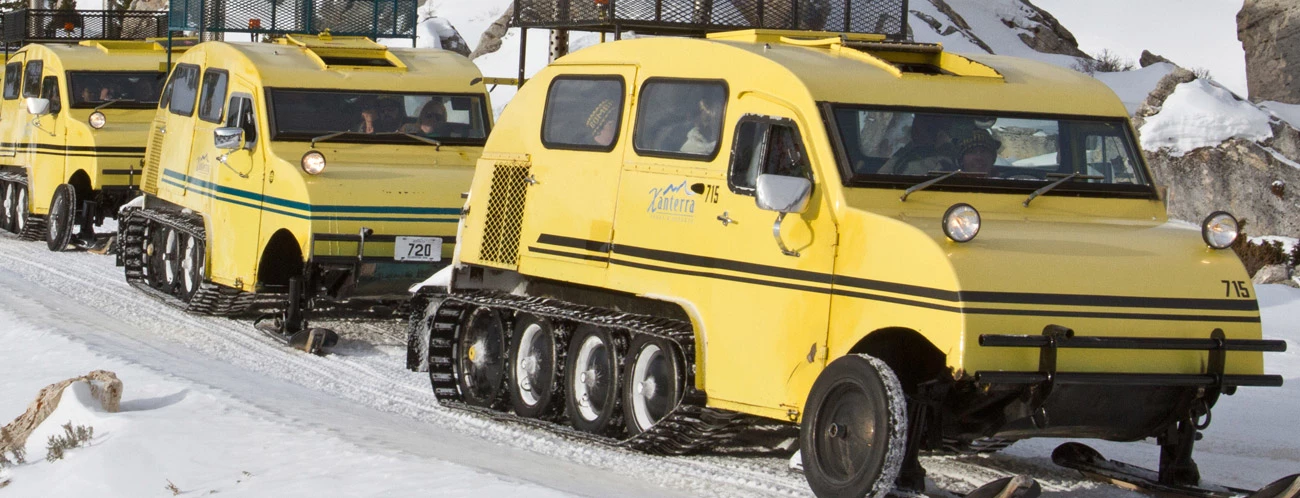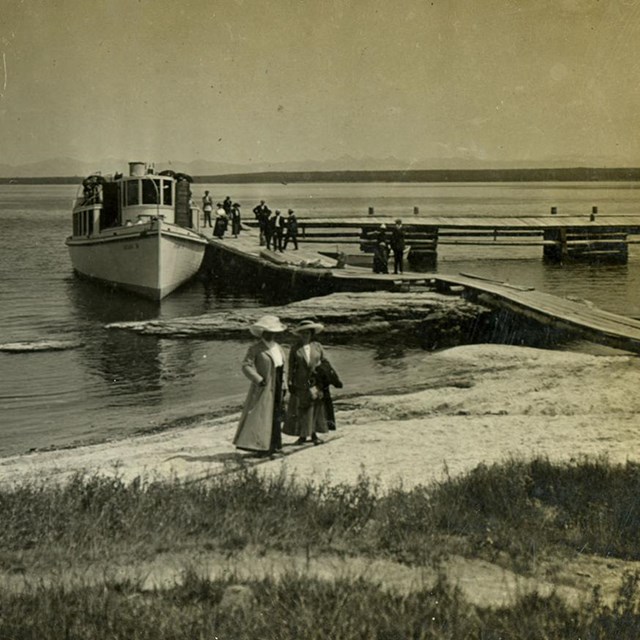
Increasing travel by motorized vehicles in the 20th century saw growth in demand for winter travel accommodations. Local groups began calling for the National Park Service to plow Yellowstone’s roads. However, the expense and difficulty of plowing the more than 140 miles of the Grand Loop Road, and the massive, view-obscuring snowbanks created by the plows, prompted the NPS to seek a different strategy for winter access.
In 1949, the NPS began allowing motorized oversnow vehicles inside park boundaries. Some of the first oversnow vehicles in the park were snowplanes, predecessors to snowmobiles. Snowplanes are designed to scoot across the snow on skis while propellers attached to the cab push the vehicle forward. Modern snowmobiles, invented in the 1950s, quickly became more popular than the older, bulky snowplanes. By the 1960s, recreation companies and park concessioners were renting snowmobiles to visitors and running tours in snowcoaches, which have large tires to cross snow and increased seating capacity.
Over the next three decades, winter tourism boomed, as did the controversy over the use of snowmobiles. These vehicles caused noise and air pollution; and their ease of off-road traveling enabled many visitors to approach and harass wildlife and enter delicate thermal areas. After decades of fierce public debate, the NPS restricted snowmobiling in the park in 2003. Administrators set a daily cap for the number of snowmobile vehicles allowed in the park, issued standards for more environmentally friendly engines, and required all snowmobilers to travel in guided groups. Restrictions are still in place today. In the winter, only the road connecting the North and Northeast Entrances is plowed. Weather permitting, cars can travel from Gardiner, Montana, and the park’s headquarters in Mammoth to the communities of Silver Gate and Cooke City.
-
 Steamer at Thumb of Yellowstone Lake
Steamer at Thumb of Yellowstone LakeYellowstone National Park, YELL 127728
-
 "Adelaide" on Yellowstone Lake
"Adelaide" on Yellowstone LakeYellowstone National Park, YELL 124208
-
 Car in Snowy Road, Opening Day
Car in Snowy Road, Opening DayYellowstone National Park, YELL 20849
-
 Scene of Snow Vehicle
Scene of Snow VehicleYellowstone National Park, YELL 124223-1
-
 Scene of Snow Vehicle
Scene of Snow VehicleYellowstone National Park, YELL 124223-2
-
 Scene of Snow Vehicle
Scene of Snow VehicleYellowstone National Park, YELL 124223-3
-
 Scene of Snow Vehicle
Scene of Snow VehicleYellowstone National Park, YELL 124223-4
-
 Scene of Snow Vehicles
Scene of Snow VehiclesYellowstone National Park, YELL 124223-5
-
 Scene of Snow Vehicle
Scene of Snow VehicleYellowstone National Park, YELL 124223-6
-
 Lemuel Garrison with Snowplane
Lemuel Garrison with SnowplaneYellowstone National Park, YELL 19968
-
 Watching Old Faithful eruption in winter
Watching Old Faithful eruption in winterYellowstone National Park, YELL 124202
-
 Winter road with station wagon
Winter road with station wagonYellowstone National Park, YELL 181649
-
 "Yellowstone NP in Winter" Pamphlet
"Yellowstone NP in Winter" PamphletYellowstone National Park, YELL 60505
-
 Snowplow clearing roads in park
Snowplow clearing roads in parkYellowstone National Park, YELL 40519
-
 Oversnow vehicle permit
Oversnow vehicle permitYellowstone National Park, YELL 14604
-
 Skiing Party near Golden Gate
Skiing Party near Golden GateYellowstone National Park, YELL 19344
-
 Last trip for Bombardier snowcoaches
Last trip for Bombardier snowcoachesNational Park Service photograph
-
 Bicycling past Castle Geyser
Bicycling past Castle GeyserNational Park Service photograph
Last updated: November 4, 2024
